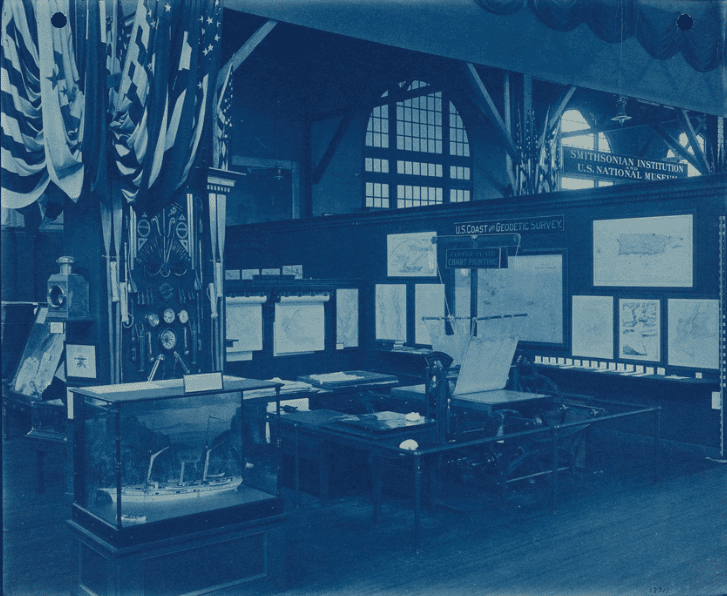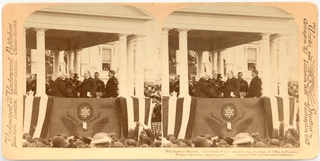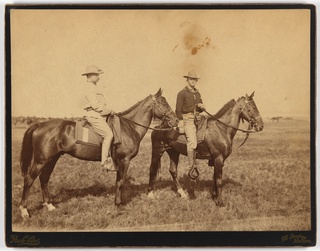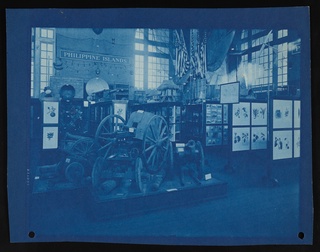Panorama of Possessions: Film, Photography, and the War of 1898
By Dalina A. Perdomo Álvarez•August 2024•9 Minute Read

United States National Museum Photographic Laboratory, Pan-American Exposition, Buffalo, New York, 1901, 1900s. Smithsonian Institution Archives, Smithsonian Institution, CC0.
Cinema and photography were invented shortly before the creation of the United States empire and were useful tools to manage public perception of that project. During this period, World’s Fair exhibitions were also a popular way to showcase the “achievements” of a nation.
“Expositions are the timekeepers of progress.”
–President William McKinley
during his last public speech
before he was assassinated at the
Pan-American Exposition in 1901.1
Introduction
The Spanish-American War has often been considered the first “media” war.2 In February of 1898, as the Cuban War of Independence brewed, the United States sent the USS Maine to Havana to protect U.S. interests. Then the battleship exploded. Although no one could verify the cause, the press sensationalized the situation and stoked the public belief that the Maine had been attacked by Spain.3 Of course, the main decision maker, President William McKinley, did not need the help of the press to pursue a war for Spain’s colonies (Cuba, the Philippines, Puerto Rico, and Guam), which the U.S. had been eyeing as the Spanish empire declined. Whether the media’s yellow journalism was to share the blame or not, the U.S. officially entered a war with Spain in April 1898.
After seven months of fighting in Cuba, the Philippines, and Puerto Rico, Spain withdrew its claim to Cuba and relinquished ownership of Puerto Rico, Guam, and the Philippines to the United States. President McKinley also used the war as a nationalist pretext to annex the Republic of Hawaiʻi as a territory in the middle of the conflict. U.S. corporations had already overthrown the Hawaiʻian Kingdom in 1893. Itself a colonized land, the U.S. gained its first overseas colonies and began its streak of military interventions abroad.
Edison Studios, Raising Old Glory over Morro Castle, 1899. Film transferred to paper. Library of Congress, public domain. "Down goes the Spanish flag, and up floats the Stars and Stripes. Down falls the symbol of tyranny and oppression that has ruled in the new world for four hundred years, and up goes the Banner of Freedom. In the distance are the turrets and battlements of Morro, the last foothold of Spain in America." The Phonoscope, January 1899.
Though its exact influence is contested, the news media played a role in these imperialist efforts, especially by capitalizing on the excitement around new technologies. The story of the creation of the U.S. empire is also a story of cinema, photography, and propaganda.

Visions and Revisions
Recently, the National Portrait Gallery’s exhibition 1898: U.S. Imperial Visions and Revisions (April 2023–February 2024) described how artists and consumer culture contributed to the way the Spanish-American War was envisioned at the time. The exhibition mainly highlighted portraiture and merchandise such as trading cards, board games, and stylized maps, but it pointedly ended with a projection of Roosevelt’s Rough Riders, a film produced by the Biograph Company that depicted the U.S. Volunteer Cavalry charging toward the camera, as if symbolically demonstrating the heroic way the war and future interventions would be viewed in its aftermath.
The American Mutoscope and Biograph Company, Roosevelt’s Rough Riders, 1898. Film transferred to paper. Library of Congress, public domain. "A charge full of cowboy enthusiasm by Troop ‘I,’ the famous regiment, at Tampa, before its departure for the front." American Mutoscope & Biograph picture catalogue.
Media and the Military
Blaming the media for stoking discord is common nowadays. But what is “the media”? In our highly visual society, people are generally referring to photography, online video, TV, and movies. While the media is often accused of promoting progressive ideals, the history behind photographic and cinematic objects suggests otherwise. Recently, there has been increased scrutiny of the close ties between Hollywood and the U.S. military, particularly because of the Department of Defense’s occasional financial and creative involvement in the string of superhero movies known as the Marvel Cinematic Universe.4 The relationship between Hollywood and the military was strengthened during World War II, but militarization of the film medium can be traced back to its origins.
War photographers have also been accused of serving imperial interests or romanticizing suffering, despite intentions to expose injustices.5 The camera has long been considered as a weapon of imperialism, with France and Britain employing ethnographic photography during their imperialist endeavors.6 The U.S. not only followed in their footsteps, but developed it further with the moving image.
Photography, Cinema, Propaganda
Photography was immediately used to celebrate the new empire through panoramas of “possessions.” Photos from the war were compiled into books such as Our Islands and Their People as Seen with Camera and Pencil; Neely’s Panorama of Our New Possessions; Photographs of the Great Spanish-American War; and Picturesque Cuba, Porto Rico, Hawaii and the Philippines: A Photographic Panorama of Our New Possessions. These publications carefully controlled the reception of their illustrations through extensive text descriptions in a hybrid visual essay format. The texts and photos were used to support racial classification systems about people who called these islands home, using racist tropes about their attitudes toward labor and progressive ideals as a way to justify the U.S. military and economic takeover.
Photographs quickly became collectible objects. By 1865, they were protected by copyright law. Motion pictures, as films were called, were not specifically protected until 1912. As a result, filmmakers and movie companies submitted their work to national archives such as the Library of Congress in the form of paper contact prints, which were essentially registered as photographs. While some producers of motion pictures only submitted illustrative sequences, the Edison Manufacturing Company and the American Mutoscope and Biograph Company, early innovators of the medium, submitted entire motion pictures frame by frame. The majority of early films have been lost to decay, fires, and neglect. Yet the Library of Congress holds one of the most extensive film collections in the world, in part because these paper prints have proved easier to preserve.
And, as key episodes of U.S. empire building coincided with the medium’s development, a significant portion of these early, printed films depicted the Pan-American Exposition and the Spanish-American War.
Edison Studios, President McKinley reviewing the troops at the Pan-American Exposition, 1901. Film transferred to paper. Library of Congress, public domain. "The President is seen on the reviewing stand at the Stadium, escorted by President Milburn, of the Pan-American Exposition, Secretary Cortelyou, and other noted persons. He removes his silk hat as the troops march by and politely bows to the great audience as they cheer and encore. President McKinley and party form the left foreground of our picture while the troops march by in the right foreground. From this excellent position we thus secured perfect pictures of both the Executive and his troops." Edison films catalog, no. 135.
The Imperial President’s Cinematic and Photographic Legacy
Edison Studios and the Biograph Company produced “actualities” (short nonfiction films considered to be precursors of the documentary genre) about the tensions and subsequent war, with the Edison Studios receiving support from newspaper publisher William Randolph Hearst. The Edison Studios claimed the moving images were “sure to satisfy the craving of the general public for absolutely true and accurate details regarding the movements of the United States Army getting ready for the invasion of Cuba.”7 These images of war also boosted cinema’s popularity in the U.S.
The Pan-American Exposition World’s Fair, held in Buffalo, New York from May 1 through November 2, 1901, epitomized its historical moment: It was initially delayed due to the outbreak of the Spanish-American War. It was the subject of what was allegedly the first American motion picture filmed outdoors at night.8 And it was the site of President McKinley’s assassination.
The exposition was thoroughly photographed, and filmed by an Edison Studios cinematographer. Notably, a panoramic motion picture documenting all of the exposition buildings after dark was said to be the first film made under those lighting conditions.9
Edison Studios, Panorama of Esplanade by Night, 1901. Film transferred to paper. Library of Congress, public domain. "A most perfect picture of the Pan-American Exposition buildings, including the Electric Tower and Temple of Music, as they appear at night." Edison films catalog.
Edison Studios, along with its competitor, Biograph, filmed McKinley’s imperialist efforts in Cuba and the Philippines during the Spanish-American War.10 They also filmed President McKinley’s second inauguration in 1901—and his funeral later that year. President McKinley was the first truly imperialist U.S. president and, in a way, the first cinematic one.
Conclusion
Edison Studios, Taking President McKinley's body from Train at Canton, Ohio, 1901. Film transferred to paper. Library of Congress, public domain. "Here, as in the other pictures, we secured a most advantageous location, and we present a life-size view of the casket containing the body of President McKinley as it is slowly and carefully taken from the window of the car which bore it from the Capitol to Canton. The casket is placed upon the shoulders of ten stalwart sailors and soldiers and borne to the waiting hearse." Edison films catalog, no. 135.
Cubans, Puerto Ricans, Guamanians, Filipinos, and Hawaiʻians are still living with the U.S. military today. The military has had a perpetual lease and territorial control on the Guantanamo Bay Naval Base in Cuba since 1903. Puerto Rico has Fort Buchanan, the only active Army installation in the Caribbean. Guam is occupied by several naval properties controlled by Joint Region Marianas, Naval Base Guam, and the Andersen Air Force base. The Army still uses the Philippines as a training ground, collaborating on exercises together with the Philippines Armed Forces. And Hawaiʻi, the only one to officially carry the title of state, is the headquarters of the United States Pacific Command.11
In the 21st century, photography, film, and now video have continued to play a role in the militarization of these islands—but our relationship to this media has evolved. In January 2002, a U.S. Marshals Service photographer’s pictures of the Guantanamo Bay prison shifted how we view U.S. detention policy.12 While released by the Pentagon as a public relations tactic to demonstrate the effectiveness of the “war on terror” and the arrival of prisoners from Afghanistan, the news media and the public interpreted the photos of the detainees kneeling before the prison guards as an image of abuse of power.13 Eyes were on Cuba again, but neither the technology nor the empire felt like a novelty this time. Have we become more careful spectators? Or are we stuck in a cycle of violent images, shock, and no change? Do we really have to see the empire to believe it?
If photography and cinema have been historically used for their subjugation, can they be used for their liberation?
Dalina A. Perdomo Álvarez is a 2024 Curationist Fellow. She is a Puerto Rican curator and writer, and currently Assistant Curator at the MSU Broad Art Museum. Previously, she was the 2018–2020 Curatorial Fellow at the Museum of Contemporary Photography, and has also worked at the Video Data Bank and The National Museum of Puerto Rican Arts and Culture. She has collaborated with several film festivals, and was selected to be the Inaugural Curatorial Fellow for the Chicago Underground Film Festival in 2021. She is a member of Blue Sky/The Oregon Center for the Photographic Arts Exhibitions Committee and is Michigan state representative for the Association of Academic Museums and Galleries. She holds an MA in Film Studies from the University of Iowa, and a BA from the University of Puerto Rico - Mayagüez.
Citations
McKinley, William. “President McKinley's Last Public Utterance to the People in Buffalo, New York.” The American Presidency Project, https://www.presidency.ucsb.edu/node/205979. Accessed August 8, 2024.
Kennedy, Lesley. “Did Yellow Journalism Fuel the Outbreak of the Spanish American War?” History, August 21, 2019, https://www.history.com/news/spanish-american-war-yellow-journalism-hearst-pulitzer. Accessed August 8. 2024.
Campbell, W. Joseph. Getting It Wrong: Debunking the Greatest Myths in American Journalism. United States: University of California Press, 2017.
Robinson, Joanna, Dave Gonzales, and Gavin Edwards. MCU: The Reign of Marvel Studios, New York: Liveright, 2023, p. 78.
Sontag, Susan. Regarding the Pain of Others. New York: Farrar, Straus and Giroux, 2003.
Azoulay, Ariella. Potential History: Unlearning Imperialism. London: Verso Books, 2019.
“‘Remember the Maine’: The Beginnings of War.” Library of Congress, https://www.loc.gov/collections/spanish-american-war-in-motion-pictures/articles-and-essays/the-motion-picture-camera-goes-to-war/remember-the-maine-the-beginnings-of-war/.
See “The Spanish American War in Motion Pictures,” Library of Congress, https://www.loc.gov/collections/spanish-american-war-in-motion-pictures/about-this-collection/.
Porter, Edwin S., James H. White, and Thomas A. Edison, Inc. “Panorama of Esplanade by Night.“ 1901, United States: Thomas A. Edison, Inc., https://www.loc.gov/item/00694344/.
Porter, et al.
See Immerwahr, Daniel. How to Hide an Empire: A History of the Greater United States. New York: Farrar, Straus and Giroux, 2019.
Struk, Janina. Private Pictures: Soldiers' Inside View of War. London: Taylor & Francis, 2020.
Dauenhauer, K. “Between Ethics and Aesthetics: Photographs of War during the Bush and Obama Administrations.” Amerikastudien/American Studies Volume 58, Issue 4 (2013), pp. 625–646.
Dalina A. Perdomo Álvarez is a 2024 Curationist Fellow. She is a Puerto Rican curator and writer, and currently Assistant Curator at the MSU Broad Art Museum. Previously, she was the 2018–2020 Curatorial Fellow at the Museum of Contemporary Photography, and has also worked at the Video Data Bank and The National Museum of Puerto Rican Arts and Culture. She has collaborated with several film festivals, and was selected to be the Inaugural Curatorial Fellow for the Chicago Underground Film Festival in 2021. She is a member of Blue Sky/The Oregon Center for the Photographic Arts Exhibitions Committee and is Michigan state representative for the Association of Academic Museums and Galleries. She holds an MA in Film Studies from the University of Iowa, and a BA from the University of Puerto Rico - Mayagüez.


